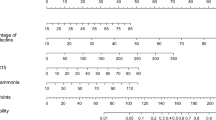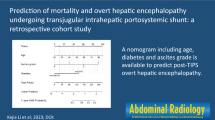Abstract
Purpose
Hepatic encephalopathy (HE) is a common complication in patients undergoing transjugular intrahepatic portosystemic shunt (TIPS). The objective of this study was to assess the prognostic factors and make risk stratification of post-TIPS HE.
Methods
This was a retrospective cohort study consisting of cirrhotic patients who had undergone TIPS creation at our center from November 2015 to August 2020. The baseline characteristics including spleen volume (SVol) and other markers were collected. The univariate and multivariate Cox regression analyses were used to identify independent predictors of post-TIPS overt HE (OHE).
Results
Higher Child–Pugh (CP) score (HR 1.334, 95% CI 1.090–1.632, P = 0.005) and smaller SVol (HR 0.999, 95% CI 0.997–1.000, P = 0.004) were identified as the independent risk factors for post-TIPS OHE. And a time-dependent ROC analysis was used to determine the cutoff values of CP score and SVol, which were respectively 6.5 and 773 cm3. Subsequently, the CP-SVol grading system was developed to divide patients into three risk grades according to the above two cutoff values. Kaplan–Meier analysis showed that the cumulative rates of patients free of OHE in Grade 1, 2 and 3 were respectively 96.4% ± 3.5%, 82.1 ± 4.7%, and 59.3% ± 6.4%, which were in descending order (Log rank P < 0.001).
Conclusion
SVol might be a novel marker to predict the prognosis of post-TIPS OHE, and the proposed CP-SVol grading system composed of CP score and SVol achieved a superior predictive performance.



Similar content being viewed by others
Data availability
Please contact the corresponding author for data request.
Abbreviations
- HE:
-
Hepatic encephalopathy
- TIPS:
-
Transjugular intrahepatic portosystemic shunt
- SVol:
-
Spleen volume
- OHE:
-
Overt hepatic encephalopathy
- CT:
-
Computed tomography
- CP:
-
Child–Pugh
- MELD:
-
Model for end-stage liver disease
- PVT:
-
Portal vein thrombosis
- SPSS:
-
Spontaneous portosystemic shunt
- PPG:
-
Portal pressure gradient
- PACS:
-
Picture archiving and communication systems
- ROI:
-
Regions of interest
- SD:
-
Standard deviation
- OR:
-
Odds ratio
- CI:
-
Confidence interval
- ROC:
-
Receiver operating characteristic
- AUC:
-
Area under the curve
References
Rössle M. TIPS: 25 years later. J Hepatol. 2013 Nov;59(5):1081-93.
Riggio O, Nardelli S, Moscucci F, Pasquale C, Ridola L, Merli M. Hepatic encephalopathy after transjugular intrahepatic portosystemic shunt. Clin Liver Dis. 2012 Feb;16(1):133-46.
Rössle M, Haag K, Ochs A, Sellinger M, Nöldge G, Perarnau JM, et al. The transjugular intrahepatic portosystemic stent-shunt procedure for variceal bleeding. N Engl J Med. 1994 Jan 20;330(3):165-71.
Nolte W, Wiltfang J, Schindler C, Münke H, Unterberg K, Zumhasch U, et al. Portosystemic hepatic encephalopathy after transjugular intrahepatic portosystemic shunt in patients with cirrhosis: clinical, laboratory, psychometric, and electroencephalographic investigations. Hepatology. 1998 Nov;28(5):1215-25.
Riggio O, Angeloni S, Salvatori FM, De Santis A, Cerini F, Farcomeni A, et al. Incidence, natural history, and risk factors of hepatic encephalopathy after transjugular intrahepatic portosystemic shunt with polytetrafluoroethylene-covered stent grafts. Am J Gastroenterol. 2008 Nov;103(11):2738-46.
Casadaban LC, Parvinian A, Minocha J, Lakhoo J, Grant CW, Ray CE Jr, et al. Clearing the Confusion over Hepatic Encephalopathy After TIPS Creation: Incidence, Prognostic Factors, and Clinical Outcomes. Dig Dis Sci. 2015 Apr;60(4):1059-66.
Fonio P, Discalzi A, Calandri M, Doriguzzi Breatta A, Bergamasco L, Martini S, et al. Incidence of hepatic encephalopathy after transjugular intrahepatic portosystemic shunt (TIPS) according to its severity and temporal grading classification. Radiol Med. 2017 Sep;122(9):713-721.
Mas A. Hepatic encephalopathy: from pathophysiology to treatment. Digestion. 2006;73 Suppl 1:86-93.
Jaffe A, Lim JK, Jakab SS. Pathophysiology of Hepatic Encephalopathy. Clin Liver Dis. 2020 May;24(2):175-188.
Orlando R, Lirussi F, Basso SM, Lumachi F. Splenomegaly as risk factor of liver cirrhosis. A retrospective cohort study of 2,525 patients who underwent laparoscopy. In Vivo. 2011 Nov-Dec;25(6):1009-12.
Shah SH, Hayes PC, Allan PL, Nicoll J, Finlayson ND. Measurement of spleen size and its relation to hypersplenism and portal hemodynamics in portal hypertension due to hepatic cirrhosis. Am J Gastroenterol. 1996 Dec;91(12):2580-3.
Cheng YF, Huang TL, Chen TY, Concejero A, Tsang LL, Wang CC, et al. Liver graft-to-recipient spleen size ratio as a novel predictor of portal hyperperfusion syndrome in living donor liver transplantation. Am J Transplant. 2006 Dec;6(12):2994-9.
Cejna M, Peck-Radosavljevic M, Thurnher S A, Hittmair K, Schoder M, Lammer J. Creation of Transjugular Intrahepatic Portosystemic Shunts with Stent-Grafts: Initial Experiences with a Polytetrafluoroethylene-covered Nitinol Endoprosthesis. Radiology. 2001, 221(2): 437-446.
Madoff DC, Gaba RC, Weber CN, Clark TW, Saad WE. Portal Venous Interventions: State of the Art. Radiology. 2016;278(2):333‐353.
Robertson F, Leander P, Ekberg O. Radiology of the spleen. Eur Radiol. 2001;11(1):80-95.
Khoshpouri P, Hazhirkarzar B, Ameli S, Pandey A, Ghadimi M, Rezvani Habibabadi R, et al. Quantitative spleen and liver volume changes predict survival of patients with primary sclerosing cholangitis. Clin Radiol. 2019 Sep;74(9):734.e13-734.e20.
American Association for the Study of Liver Diseases; European Association for the Study of the Liver. Hepatic encephalopathy in chronic liver disease: 2014 practice guideline by the European Association for the Study of the Liver and the American Association for the Study of Liver Diseases. J Hepatol. 2014 Sep;61(3):642-59.
Ichai P, Samuel D. Etiology and prognosis of fulminant hepatitis in adults. Liver Transpl. 2008 Oct;14 Suppl 2:S67-79.
Krishnarao A, Gordon FD. Prognosis of Hepatic Encephalopathy. Clin Liver Dis. 2020 May;24(2):219-229.
Riggio O, Masini A, Efrati C, Nicolao F, Angeloni S, Salvatori FM, et al. Pharmacological prophylaxis of hepatic encephalopathy after transjugular intrahepatic portosystemic shunt: a randomized controlled study. J Hepatol. 2005 May;42(5):674-9.
Bai M, Qi X, Yang Z, Nie Y, Yuan S, Wu K, et al. Predictors of hepatic encephalopathy after transjugular intrahepatic portosystemic shunt in cirrhotic patients: a systematic review. J Gastroenterol Hepatol. 2011 Jun;26(6):943-51.
Merola J, Chaudhary N, Qian M, Jow A, Barboza K, Charles H, et al. Hyponatremia: A Risk Factor for Early Overt Encephalopathy after Transjugular Intrahepatic Portosystemic Shunt Creation. J Clin Med. 2014 Apr 4;3(2):359-72.
. Chen L, Xiao T, Chen W, Long Q, Li R, Fang D, et al. Outcomes of transjugular intrahepatic portosystemic shunt through the left branch vs. the right branch of the portal vein in advanced cirrhosis: a randomized trial. Liver Int. 2009 Aug;29(7):1101-9.
Lewis DS, Lee TH, Konanur M, Ziegler C, Hall MD, Pabon-Ramos WM, et al. Proton Pump Inhibitor Use Is Associated with an Increased Frequency of New or Worsening Hepatic Encephalopathy after Transjugular Intrahepatic Portosystemic Shunt Creation. J Vasc Interv Radiol. 2019 Feb;30(2):163-169.
Gioia S, Merli M, Nardelli S, Lattanzi B, Pitocchi F, Ridola L, et al. The modification of quantity and quality of muscle mass improves the cognitive impairment after TIPS. Liver Int. 2019 May;39(5):871-877.
Wang Q, Lv Y, Bai M, Wang Z, Liu H, He C, et al. Eight millimetre covered TIPS does not compromise shunt function but reduces hepatic encephalopathy in preventing variceal rebleeding. J Hepatol. 2017 Sep;67(3):508-516.
Schepis F, Vizzutti F, Garcia-Tsao G, Marzocchi G, Rega L, De Maria N, Di Maira T, et al. Under-dilated TIPS Associate With Efficacy and Reduced Encephalopathy in a Prospective, Non-randomized Study of Patients With Cirrhosis. Clin Gastroenterol Hepatol. 2018 Jul;16(7):1153-1162.e7.
Cui J, Smolinski SE, Liu F, Xu D, Dulaimy K, Irani Z. Incrementally Expandable Transjugular Intrahepatic Portosystemic Shunts: Single-Center Experience. AJR Am J Roentgenol. 2018 Feb;210(2):438-446.
Luo L, Fu S, Zhang Y, Wang J. Early diet intervention to reduce the incidence of hepatic encephalopathy in cirrhosis patients: post-Transjugular Intrahepatic Portosystemic Shunt (TIPS) findings. Asia Pac J Clin Nutr. 2016;25(3):497-503.
Acknowledgements
This study was funded by Grant from National Nature Science Foundation of China (Grant no. 81873917).
Funding
This study was funded by Grant from National Nature Science Foundation of China (Grant No. 81873917).
Author information
Authors and Affiliations
Contributions
Study conception and design: BX and JL; acquisition of data: JL, CZ, YW, QS and CY; analysis and interpretation of data: JL, CZ, SH, YC and TL; drafting of manuscript: JL and CZ; and critical revision: BX.
Corresponding author
Ethics declarations
Conflict of interest
The authors declare that they have no conflict of interest.
Ethical approval
All procedures performed in studies involving human participants were in accordance with the ethical standards of the institutional and/or national research committee and with the 1964 Helsinki declaration and its later amendments or comparable ethical standards. This retrospective study was approved by the institutional review board of the Union Hospital, Tongji Medical college, Huazhong University of Science and Technology.
Informed consent
As a retrospective analysis, informed consent in this study was waived.
Additional information
Publisher's Note
Springer Nature remains neutral with regard to jurisdictional claims in published maps and institutional affiliations.
Rights and permissions
About this article
Cite this article
Liu, J., Zhou, C., Wang, Y. et al. The combination of Child–Pugh score and quantitative CT-based spleen volume could predict the risk of hepatic encephalopathy after transjugular intrahepatic portosystemic shunt creation. Abdom Radiol 46, 3464–3470 (2021). https://doi.org/10.1007/s00261-021-02972-6
Received:
Revised:
Accepted:
Published:
Issue Date:
DOI: https://doi.org/10.1007/s00261-021-02972-6




